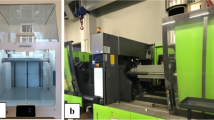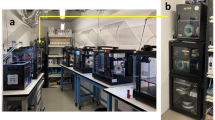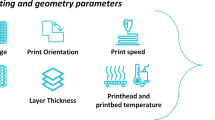Abstract
This feasibility study aims to determine if a low-cost 3D printer (BitsFromBytes 3D Touch) with ABS plastic can print custom mould structures and catheter channels defined in a brachytherapy treatment planning system (Nucletron Oncentra) for patient-specific treatment. Printer accuracy was evaluated through physical measurement, and print quality was investigated by adjusting print parameters (print speed, layer thickness, percentage infill). Catheter positioning and reproducibility were measured over repeated insertions. ABS plastic water equivalency was investigated by comparing Ir-192 HDR source dose distributions, measured with radiochromic film, in ABS plastic and in water. Structures and catheter channels were printed accurately to within 0.5 mm laterally and 1 mm in the vertical print direction. Adjusting print parameters could reduce print time, albeit with reduced print quality. 3.5 mm channel diameters allowed for easy catheter insertion. Catheter positioning was reproducible to within 0.5 mm but, because of catheter flex within the channel, was on average 1 mm offset from defined TPS positions. This offset could be accounted for by repeating the treatment planning CT scan with the printed mould positioned on the patient. Dose attenuation in ABS plastic and in water was equivalent to within the measurement limitations. While clinical uses for this particular low-cost printer and ABS plastic are limited by print size restrictions and non-certification for biocompatibility, it has been demonstrated that a low-cost 3D printer set-up can accurately create custom moulds and catheter channels potentially acceptable for clinical use.










Similar content being viewed by others
References
Gerbaulet A, Pötter R, Mazeron J-J, Meertens H, Van Limbergen E (eds) (2002) The GEC ESTRO handbook of brachytherapy. ACCO, Leuven, pp 313–315
De Boeck L, Beliën J, Egyed W (2014) Dose optimization in HDR brachytherapy: a literature review of quantitative models from 1990 to 2010. Oper Res Health Care 3(2):80–90
Shwetha B, Ravikumar M, Katke A, Supe SS, VenkataGiri G, Ramanand N, Pasha T (2010) Dosimetric comparison of various optimization techniques for high dose rate brachytherapy of interstitial cervix implants. J Appl Clin Med Phys 11(3):225–230
Gerbaulet A, Pötter R, Mazeron J-J, Meertens H, Van Limbergen E (eds) (2002) The GEC ESTRO handbook of brachytherapy. ACCO, Leuven, pp 316–318
Gerbaulet A, Pötter R, Mazeron J-J, Meertens H, Van Limbergen E (eds) (2002) The GEC ESTRO handbook of brachytherapy. ACCO, Leuven, p 578
Guix B, Finestres F, Tello JI, Palma C, Martinez A, Guix JR, Guix R (2000) Treatment of skin carcinomas of the face by high-dose-rate brachytherapy and custom-made molds. Int J Radiat Oncol Biol Phys 47(1):95–102
The Economist (2013) 3D printing scales up. The Economist Newspaper.http://www.economist.com/news/technology-quarterly/21584447-digital-manufacturing-there-lot-hype-around-3d-printing-it-fast.. Accessed 22 Sept 2014
Cumming I, Joshi CP, Lasso A, Rankin A, Falkson C, John Schreiner L, Fichtinger G (2014) SU-E-T-04: 3D printed patient-specific surface mould applicators for brachytherapy treatment of superficial lesions. Med Phys 41:222
Cunha J, Sethi R, Mellis K, Siauw T, Sudhyadhom A, Hsu I, Pouliot J (2014) WE-F-16A-01: commissioning and clinical use of PC-ISO for customized, 3D printed, gynecological brachytherapy applicators. Med Phys 41:514
Cunha JAM, Mellis K, Sethi R, Siauw T, Sudhyadhom A, Garg A, Goldberg K, Hsu I-C, Pouliot J (2015) Evaluation of PC-ISO for customised, 3D printed, gynecologic 192IR HDR brachytherapy applicators. JACMP 16(1):246–253
Poulin E, Gardi L, Fenster A, Pouliot J, Beaulieu L (2014) A novel approach for real-time, personalized breast HDR brachytherapy treatment using 3D printing technology. Brachytherapy 13(S1):S18
Garg A, Patil S, Siauw T, Cunha AM, Hsu IC, Abbeel P, Pouliot J, Goldberg K (2013) An algorithm for computing customised 3D printed implants with curvature constrained channels for enhancing intracavitary brachytherapy radiation delivery. IEEE Int Conf Autom Sci Eng (CASE) 2013:466–473
Stratasys Inc. (2012) Form 10-K: Annual Report.http://investors.stratasys.com/secfiling.cfm?filingID=1206774-12-1018&CIK=915735. Accessed 14 Feb 2015
BitsFromBytes/3D Systems Inc. (2011) 3D Touch: Make personal colour manufacturing a reality.http://cubify.s3.amazonaws.com/public/bfb/0911_touch_uk_3ds.pdf. 14 Feb 2015
Gibson I, Rosen DW, Stucker B (2010) Additive manufacturing technologies: rapid prototyping to direct digital manufacturing. Springer, New York, pp 143–156
Chilson, L (2013) The difference between ABS and PLA for 3D printing. ProtoParadigm,http://www.protoparadigm.com/news-updates/the-difference-between-abs-and-pla-for-3d-printing/. Accessed 10 Feb 2015
RapMan Australia (n.d.) Materials: ABS (Acrylonitrile Butadiene Styrene).http://www.rap-man.com.au/Material_files/ABSMaterial.html. Accessed 10 Feb 2015
White, D (n.d.) Health and Safety and sample risk assessment for RapMan and BfB3000 3D printers.http://www.rap-man.com.au/Downloads/Generic_Health_and_Safety_V3.pdf. Accessed 10 Feb 2015
3D Systems (2013) Safety data sheet: cube ABS plastic/CubeX ABS plastic.http://cubify.s3.amazonaws.com/public/sds/cube_cubex_sds_abs_english.pdf. Accessed 10 Feb 2015
Turk, G (1994) The PLY polygon file format. The Board of Trustees of The Leland Stanford Junior University.http://www.dcs.ed.ac.uk/teaching/cs4/www/graphics/Web/ply.html. Accessed 3 Feb 2015
Gibson I, Rosen DW, Stucker B (2010) Additive manufacturing technologies: rapid prototyping to direct digital manufacturing. Springer, New York, pp 341–343
3DVerkstan (2015). A visual ultimaker troubleshooting guide.http://support.3dverkstan.se/article/23-a-visual-ultimaker-troubleshooting-guide. Accessed 14 Feb 2015
3D Systems Inc. (2011) 3D Touch.http://cubify.s3.amazonaws.com/public/bfb/0911_touch_uk_3ds.pdf. Accessed 14 Feb 2015
Stratasys Inc. (2009) FORTUS 360mc/400mc ACCURACY STUDY.http://www.stratasys.com/resources/~/media/748AD69721184448AF46F0C37BBD205B.pdf. Accessed 14 Feb 2015
3DVerkstan (2015) Getting better prints.http://support.3dverkstan.se/article/30-getting-better-prints. Accessed 14 Feb 2015
Airwolf 3D Printers (2015) Airwolf 3D FAQ. http://airwolf3d.com/faq/.Accessed 14 Feb 2015
Materialise (n.d.) Magics: Premier Software for Additive Manufacturing Professionals. http://software.materialise.com/sites/default/files/public/SAM/Products/Magics/broch_magics_3fold_a4_eng.pdf. Accessed 14 Feb 2015
Kumar R, Sharma SD, Despande S, Ghadi Y, Shaiju VS, Amols HI, Mayya YS (2009) Acrylonitrile butadiene styrene (ABS) plastic-based low cost tissue equivalent phantom for verification dosimetry in IMRT. JACMP 11(1):24–32
Rivard MJ, Coursey BM, DeWerd LA, Hanson WF, Saiful Huq M, Ibbott GS, Mitch MG, Nath R, Williamson JF (2004) Update of AAPM task group No. 43 report: a revised AAPM protocol for brachytherapy dose calculations. Med Phys 31(3):633–674
IC3D, LLC. (2014) 3D Printing Tips & Tricks.http://www.ic3dprinters.com/3d-printing-tips-tricks/. Accessed 14 Feb 2015
BitsFromBytes/3D Systems Inc. (2011) 3D touch: set up and operations manual: 1.5.5 Print Material.http://cubify.s3.amazonaws.com/public/bfb/3dtouch_setup_operations_manual.pdf. Accessed 14 Feb 2015
Frisch Labor Systems (n.d.) Online Shop: Impression technique: Fricotan A + B. http://www.frisch-labor-systems.de/index.php?201010-FRICOTAN-A—B5062f30df3807. Accessed 14 Feb 2015
Stratasys Inc. (2015) PC-ISO: Create biocompatible parts with superior strength.http://www.stratasys.com/materials/fdm/pc-iso. Accessed 14 Feb 2015
Stratasys Inc. (2015) ABS-M30i: 3D print biocompatible, sterilizable parts.http://www.stratasys.com/materials/fdm/abs-m30i. Accessed 14 Feb 2015
Author information
Authors and Affiliations
Corresponding author
Rights and permissions
About this article
Cite this article
Harris, B.D., Nilsson, S. & Poole, C.M. A feasibility study for using ABS plastic and a low-cost 3D printer for patient-specific brachytherapy mould design. Australas Phys Eng Sci Med 38, 399–412 (2015). https://doi.org/10.1007/s13246-015-0356-3
Received:
Accepted:
Published:
Issue Date:
DOI: https://doi.org/10.1007/s13246-015-0356-3




